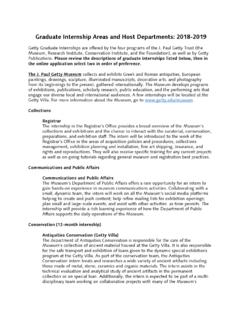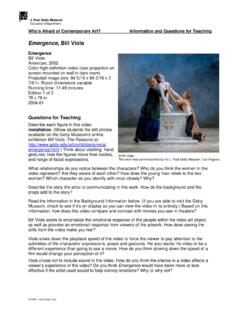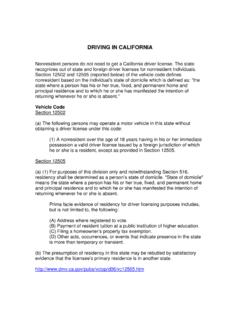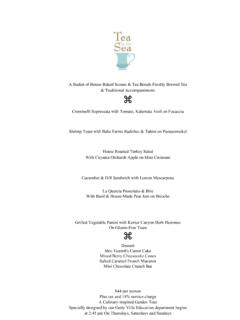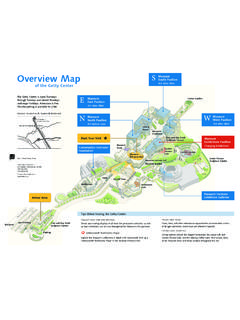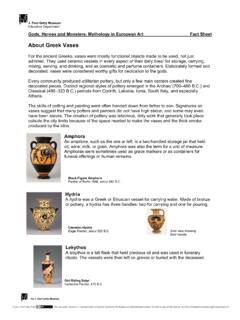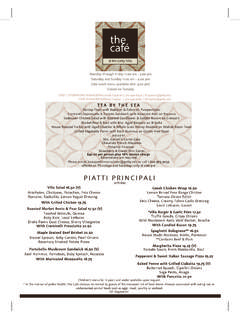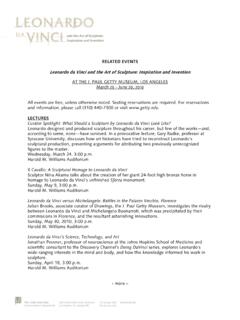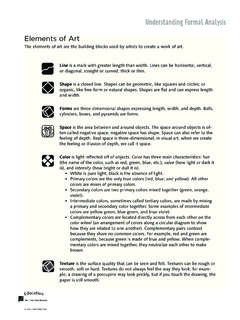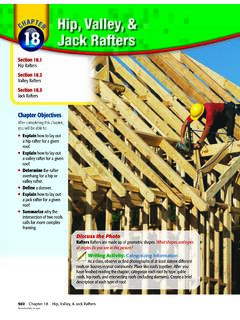Transcription of 2. What Are Controlled Vocabularies? - Getty
1 2. What Are Controlled Vocabularies? A Controlled vocabulary is an organized arrangement of words and phrases used to index content and/or to retrieve content through browsing or searching. It typically includes preferred and variant terms and has a defined scope or describes a specific Purpose of Controlled VocabulariesThe purpose of Controlled vocabularies is to organize information and to provide terminology to catalog and retrieve information. While capturing the richness of variant terms, Controlled vocabularies also promote consistency in preferred terms and the assignment of the same terms to similar that a shared goal of the cultural heritage community is to improve access to visual arts and material culture information, Controlled vocabularies are essential. They are necessary at the indexing phase because without them catalogers will not consistently use the same term to refer to the same person, place, or thing.
2 In the retrieval process, various end users may use different synonyms or more generic terms to refer to a given concept. End users are often not specialists and thus need to be guided because they may not know the correct most important functions of a Controlled vocabulary are to gather together variant terms and synonyms for concepts and to link concepts in a logical order or sort them into categories. Are a rose window and a Catherine wheel the same thing? How is pot-metal glass related to the more general term stained glass? The links and relationships in a Controlled vocabulary ensure that these connections are defined and maintained, for both cataloging and Display Information and Controlled InformationRecords for cultural objects typically contain both descriptive data and administrative data, which are outlined and defined in CCO and CDWA . Data elements record an identification of the type of object, creation information, dates of creation, place of origin and current loca-tion, subject matter, and physical description, as well as administrative 121313information about provenance, history, acquisition, conservation, context related to other objects, and the published sources of this descriptive and administrative data must be maintained in ways that will accommodate two categories of information: information intended for display to end users and information intended for retrieval.
3 Information utilized for retrieval should be adapted for Controlled vocab-ularies and Controlled are the display and indexing of information separate issues? Art and cultural heritage information provides unique chal-lenges in display and retrieval. Information must be displayed to users in a way that allows expression of nuance, ambiguity, and uncertainty. The facts about cultural objects and their creators are not always known or straightforward, and it is misleading and contrary to the tenets of scholarship to fail to express this uncertainty. At the same time, efficient retrieval requires indexing according to consistent, well-defined rules and Controlled successful catalog of art and cultural heritage information maintains a balance between flexible standards and consistent rules. On the one hand, it must be flexible in allowing the expression of uncer-tainty and ambiguity where the discipline requires it, while also accom-modating nuance and differences in style between departments and institutions.
4 On the other hand, it must apply rules consistently where it is most critical namely, for information that is indexed for the context of this book, the Controlled fields in a record are specially formatted and often linked to Controlled vocabularies (authori-ties), Controlled lists, or ruled by formatting restrictions ( , formatting of numbers) to allow for successful a full list of fields for art information and their require-ments for free-text, Controlled format, or Controlled vocabulary , see CDWA (fields and rules) and CCO (detailed rules for a subset of the CDWA categories). Display Information with Controlled VocabulariesIt is often necessary to allow fuzziness in the expression of informa-tion that at the same time must be retrievable via terminology from a Controlled vocabulary ; in certain key areas of a work record, this is accomplished by including separate display and indexing fields for the same information.
5 For example, in the creation statement and in technique, medium, and support statements, the information may be complex and may include indications of uncertainty through the use of words such as or or most effective way to express the nuances of such informa-tion is to use natural language in a display field and to index the same What Are Controlled Vocabularies? 1414information separately, using Controlled vocabulary (typically contained in an authority file). In the examples below, the creator s role is indexed with Controlled terms, and the identity of the creator is indexed as well. The Creator Description field is free text, and authority files control the other fields. See Chapter 6: Local Authorities for a discussion of authority files and local Description: Vincent van Gogh (Dutch, 1853 1890)Role: painter Identity: Gogh, Vincent vanCreator Description: Marco Ricci (Venetian, 1676 1730), figures by Sebastiano Ricci (Venetian, 1659 1734)Role: painter Extent: landscape | architecture Identity: Ricci, MarcoRole: painter Extent: figures Identity: Ricci, SebastianoCreator Description: primary painter and calligrapher was Dai Xi (Chinese, 1801 1860), with additional inscriptions and colophons added by other officials; commissioned by Wu ZhongzhunRoles: painter | calligrapher Identity: Dai XiRole: patron Identity: Wu Controlled Vocabularies vs.
6 Controlled FormatWhile Controlled vocabularies are organized sets of Controlled termi-nology values (often with other information as well), the term Controlled format refers to rules concerning the allowable data types and formatting of information. Fields may have Controlled format in addition to being linked to Controlled vocabulary , or the Controlled format may exist in the absence of any finite Controlled list of acceptable format may govern the expression of Unicode or other characters in either a free-text field or in a field that is linked to a Controlled vocabulary . Controlled format is also suitable for recording measurements, geographic coordinates, and other information in fields where numbers or codes are used. Restrictions may be placed on the field in order to regulate the number of digits allowed, the expression of deci-mals and negative numbers, and so on, ideally in compliance with ISO, NISO, or another appropriate standard where examples below juxtapose a set of materials fields that use display and Controlled vocabulary fields with a set of measurements fields.
7 Fields such as Role and Material Name contain Controlled vocabulary . However, in the measurements fields, the numbers in Value are indexed with Controlled format but not Controlled to Controlled Vocabularies1515 Materials/Techniques Description: egg-tempera paint with tooled gold-leaf halos on panelRole: medium Material Name: egg tempera | gold leafRole: support Material Name: wood panelTechnique Name: painting | gold toolingDimensions Description: comprises 10 panels; overall: 280 215 17 cm (1101 4 845 8 63 4 inches)Extent: componentsVa lue: 10 Ty p e : countVa lue: 280 Unit: cm Ty p e : heightValue: 215 Unit: cm Type: widthValue: 17 Unit: cm Ty p e : depthControlled format is also typically used for dates, such as the date of discovery or date of creation of an artwork. For such dates, Controlled fields may be used in combination with a Display Date issues involved in recording data about dates illustrate the necessity of displaying information in a way that accurately expresses nuance and ambiguity to the end user, while at the same time formatting the dates consistently to allow retrieval.
8 A free-text field for a Display Date can be used to express complex concepts and nuance, as in the examples Creation Date: probably 1711 Display Creation Date: ca. 1910 ca. 1915 Display Creation Date: designed in the 1470s, constructed 1584 1627 The Display Date field should be combined with Controlled Earliest Date and Latest Date fields that contain beginning and ending limits to enable searches on spans of time. The cataloger may estimate Earliest and Latest dates to allow for the leeway required by expressions such as ca., before, or Controlled Earliest and Latest fields do not contain Controlled vocabulary per se, but they require a Controlled format in which only numbers are allowed. A minus sign can be used to express dates bce (Before Current Era) as negative numbers; dates ce (Current Era) are positive numbers. A rule should be in place ensuring that the latest date is always greater than or equal to the earliest Creation Date: ca.
9 1913 Earliest: 1908 Latest: 1918 What Are Controlled Vocabularies? 1616 Display Creation Date: constructed 286 199 bceEarliest: 286 Latest: 199 Display Creation Date: 12th centuryEarliest: 1100 Latest: 1199 Display Creation Date: Middle Minoan Palace period, ca. 1600 bceEarliest: 1630 Latest: 1570 Display Creation Date: 1039 anno Hegirae (1630 ce)Earliest: 1630 Latest: 1630 Date fields should typically be Controlled through locally defined rules rather than with default rules contained in the system. Although most systems promote the use of a special data type called date with predefined rules, this standard date data type does not generally work because art information requires the expression of dates up to many thousands of years bce, and standard date data types are intended only for more modern dates ( , allowing 8-byte integers that represent dates ranging from 1 January of the year 0001 through 31 December of the year 9999).
10 Types of Controlled VocabulariesMost Controlled vocabularies discussed in this book are structured vocab-ularies. A structured vocabulary emphasizes relationships between and among the concepts represented by the terms or names in a Relationships in GeneralIn the context of this book, the term relationship means a state of connectedness or an association between two things in a database in this case, fields or tables in a database for a Controlled important type of relationship is between equivalents; for example, Harlem Renaissance and New Negro Renaissance refer to the same cultural movement that flourished in New York City in the relationships in a structured vocabulary include links that organize terms and provide context; for example, when discussing architectural drawings, an orthographic projection is a type of (child of ) parallel projection and a sibling of axonometric projection, all of which are organized under processes and most common types of Controlled vocabularies used for art and architecture include subject heading lists, simple Controlled lists, synonym ring lists, taxonomies, and thesauri.
